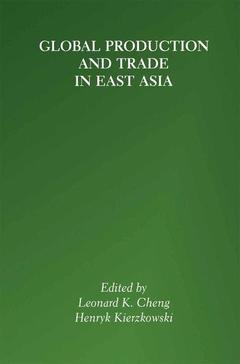Description
Global Production and Trade in East Asia, 2001
Coordinators: Cheng Leonard K., Kierzkowski Henryk
Language: English
Subjects for Global Production and Trade in East Asia:
Keywords
Asia; Asia-Pacific; Asian Economies; China; EU; East Asia; International Business; International Economics
Global Production and Trade in East Asia
Publication date: 10-2012
350 p. · 15.5x23.5 cm · Paperback
Publication date: 10-2012
350 p. · 15.5x23.5 cm · Paperback
Approximative price 158.24 €
Subject to availability at the publisher.
Add to cart
Global production and trade in east asia (POD)
Publication date: 07-2001
Support: Print on demand
Publication date: 07-2001
Support: Print on demand
Description
/li>Contents
/li>
Global Production and Trade in East Asia focuses on the profound change that the traditional paradigm of production and international trade has undergone in the last two decades or so as a result of worldwide trade and investment liberalization. This ongoing transformation has been both aided and stimulated by advances in telecommunications, transportation, and information management. The liberalization of trade and investment on the one hand and advances in communications technology on the other have further promoted global production networks in which vertical stages of final goods are fragmented across countries. International fragmentation of production, which enables international division of labor not only in final products but also in vertically related components, is more evident than ever before.
The book documents the process of international production fragmentation and trade in East Asian economies, studies the mechanics of the process, explores the theory behind the phenomenon, and identifies important policy implications. It focuses on production fragmentation and trade in East Asia because this is the part of the world where the phenomenon is most visible. With contribution by well-known international economics scholars from North America, Europe, and the Asia-Pacific, the book distinguishes itself with high global quality and rich regional content. It achieves a fine balance between theory, policy, and empirical work.
This book will interest scholars of international trade, foreign investment and international business, regional specialists in East Asian economies, policymakers and advisors in international economic relations, and anyone else who follows important economic issues of globalization.
The book documents the process of international production fragmentation and trade in East Asian economies, studies the mechanics of the process, explores the theory behind the phenomenon, and identifies important policy implications. It focuses on production fragmentation and trade in East Asia because this is the part of the world where the phenomenon is most visible. With contribution by well-known international economics scholars from North America, Europe, and the Asia-Pacific, the book distinguishes itself with high global quality and rich regional content. It achieves a fine balance between theory, policy, and empirical work.
This book will interest scholars of international trade, foreign investment and international business, regional specialists in East Asian economies, policymakers and advisors in international economic relations, and anyone else who follows important economic issues of globalization.
1. Introduction; L.K. Cheng, H. Kierzkowski. 2. Financial Crisis, Trade, and Fragmentation; A. Deardorff. 3. Horizontal Aspects of Vertical Fragmentation; R.W. Jones, H. Kierzkowski. 4. Function vs. Form in the Fragmented Industrial Structure: Three Examples from Asia Pacific Experience; H. Wan, Jr. 5. Production Sharing in East Asia: Who Does What for Whom, and Why? F. Ng, A. Yeats. 6. Intra-Industry Foreign Direct Investment and Trade Flows: New Measures of Global Competition; D. Greenaway, et al. 7. Fragmentation, Internalization, and Interfirm Linkages: Evidence from the Micro Data of Japanese Manufacturing Firms; F. Kimura. 8. Sanyal and Jones on Fragmentation and Trade: Empirical Evidence for South Korea; U. Kohli. 9. Taiwan's High-Tech Industries; C. Schive, R.Y.-S. Chyn. 10. Export-Oriented Foreign Direct Investment in the People's Republic of China: Division of Value Added between Source and Host Economies; Y.-W. Sung. 11. The Globalization of Trade and Production: A Case Study of Hong Kong's Textile and Clothing Industries; L.K. Cheng, W.K. Fung. 12. The Changing Pattern of Production Fragmentation in Singapore, and Its Economic Consequences; H.T. Hoon, K.W. Ho. 13. The Implications of Increasing Fragmentation and Globalization for the World Trade Organization; R.E. Baldwin. 14. Rules of Origin and Fragmentation of Trade; P. Lloyd. 15. Intrafirm Fragmentation: Fujitsu, Ltd.'s Production of Hard Disk Drives; F. Kimura. 16. The Development Pattern of Taiwan's Bicycle Industry; W.-w. Chu. 17. Taiwan's Integrated Circuit Industry; A.-C. Tung. 18. A Case Study of Tech Tronic Industries Co., Ltd.; H. Kierzkowski. 19. Li & Fung Ltd: An Agent of Global Production; L.K. Cheng. 20. Arms-Length Transactions vs. Affiliates: A Study of Two Electronic Components Firms in Singapore; H.T. Hoon, K.W. Ho.
© 2024 LAVOISIER S.A.S.




